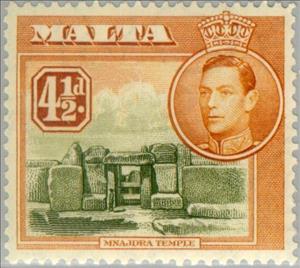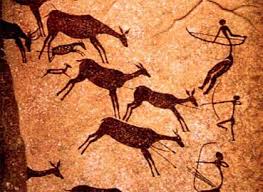Stamp: Mnajdra Temple (Malta 1938)
Mnajdra Temple (Malta 1938)
17 February (Malta ) within release King George VI goes into circulation Stamp Mnajdra Temple face value 4½ Maltese penny
| Stamp Mnajdra Temple in catalogues | |
|---|---|
| Michel: | Mi:MT 183 |
| Stamp Number: | Sn:MT 198 |
| Yvert et Tellier: | Yt:MT 185 |
| Stanley Gibbons: | Sg:MT 224 |
Stamp is horizontal format.
Also in the issue King George VI:
- Stamp - Grand Harbour, Valetta face value 1;
- Stamp - Mdina face value 2;
- Stamp - Statue of Neptune face value 2'6;
- Stamp - H.M.S. St. Angelo face value ½;
- Stamp - Verdala Palace face value 1;
- Stamp - Neolithic Hypogeum face value 1½;
- Stamp - Victoria and the Citadel, Gozo face value 2;
- Stamp - De L'Isle entering Mdina face value 2½;
- Stamp - St John's Co-Cathedral face value 3;
- Stamp - Mnajdra Temple face value 4½;
- Stamp - Statue of Manoel de Vilhena face value 6;
- Stamp - Maltese Girl face value 1;
- Stamp - St Publius face value 1'6;
- Stamp - Palace Square face value 5;
- Stamp - St Paul face value 10;
|
Data entry completed
83%
|
|
|---|---|
| Stamp Mnajdra Temple in digits | |
| Country: | Malta |
| Date: | 1938-02-17 |
| Size: | 34 x 30 |
| Perforation: | 12½ |
| Emission: | Definitive |
| Format: | Stamp |
| Face Value: | 4½ Maltese penny |
Stamp Mnajdra Temple it reflects the thematic directions:
A head of state (or chief of state) is the public persona that officially represents the national unity and legitimacy of a sovereign state. In some countries, the head of state is a ceremonial figurehead with limited or no executive power, while in others, the head of state is also the head of government. In countries with parliamentary governments, the head of state is typically a ceremonial figurehead that does not actually guide day-to-day government activities and may not be empowered to exercise any kind of secular political authority (e.g., Queen Elizabeth II as Head of the Commonwealth). In countries where the head of state is also the head of government, the president serves as both a public figurehead and the actual highest ranking political leader who oversees the executive branch (e.g., the President of the United States).
Prehistory, also called pre-literary history, is the period of human history between the first known use of stone tools by hominins c. 3.3 million years ago and the beginning of recorded history with the invention of writing systems. The use of symbols, marks, and images appears very early among humans, but the earliest known writing systems appeared c. 5,200 years ago. It took thousands of years for writing systems to be widely adopted, with writing spreading to almost all cultures by the 19th century. The end of prehistory therefore came at different times in different places, and the term is less often used in discussing societies where prehistory ended relatively recently.
King is the title given to a male monarch in a variety of contexts. The female equivalent is queen regnant (while the title of queen on its own usually refers to the consort of a king). In the context of prehistory, antiquity and contemporary indigenous peoples, the title may refer to tribal kingship. Germanic kingship is cognate with Indo-European traditions of tribal rulership (c.f. Indic rājan, Gothic reiks, and Old Irish rí, etc.) In the context of classical antiquity, king may translate Latin rex or either Greek archon or basileus. In classical European feudalism, the title of king as the ruler of a kingdom is understood as the highest rank in the feudal order, potentially subject, at least nominally, only to an emperor (harking back to the client kings of the Roman Empire). In a modern context, the title may refer to the ruler of one of a number of modern monarchies (either absolute or constitutional). The title of king is used alongside other titles for monarchs, in the West prince, emperor, archduke, duke or grand duke, in the Middle East sultan or emir; etc. Kings, like other royalty, tend to wear purple because purple was an expensive color to wear in the past.
A temple (from the Latin word templum) is a building reserved for religious or spiritual rituals and activities such as prayer and sacrifice. It is typically used for such buildings belonging to all faiths where a more specific term such as church, mosque or synagogue is not generally used in English. These include Hinduism, Buddhism, and Jainism among religions with many modern followers, as well as other ancient religions such as Ancient Egyptian religion.




